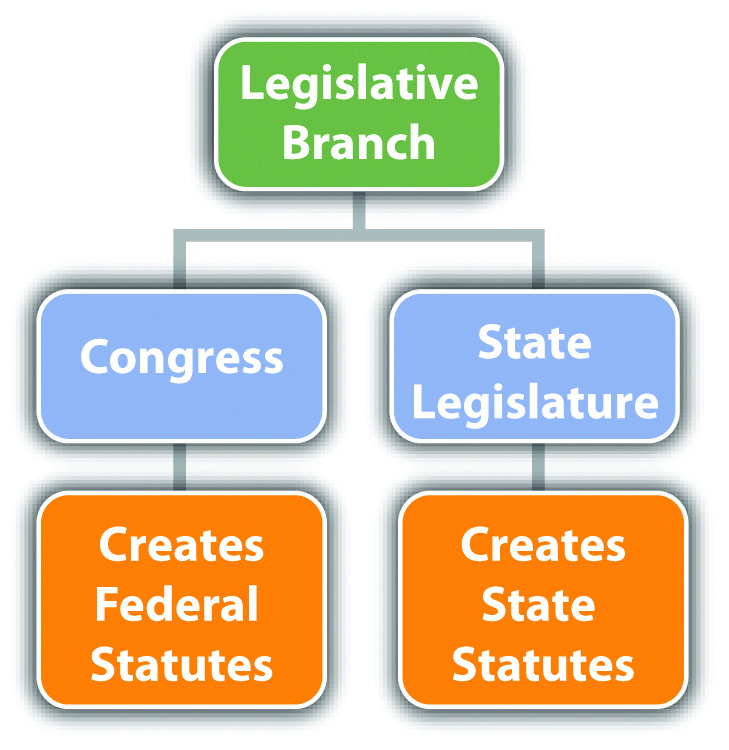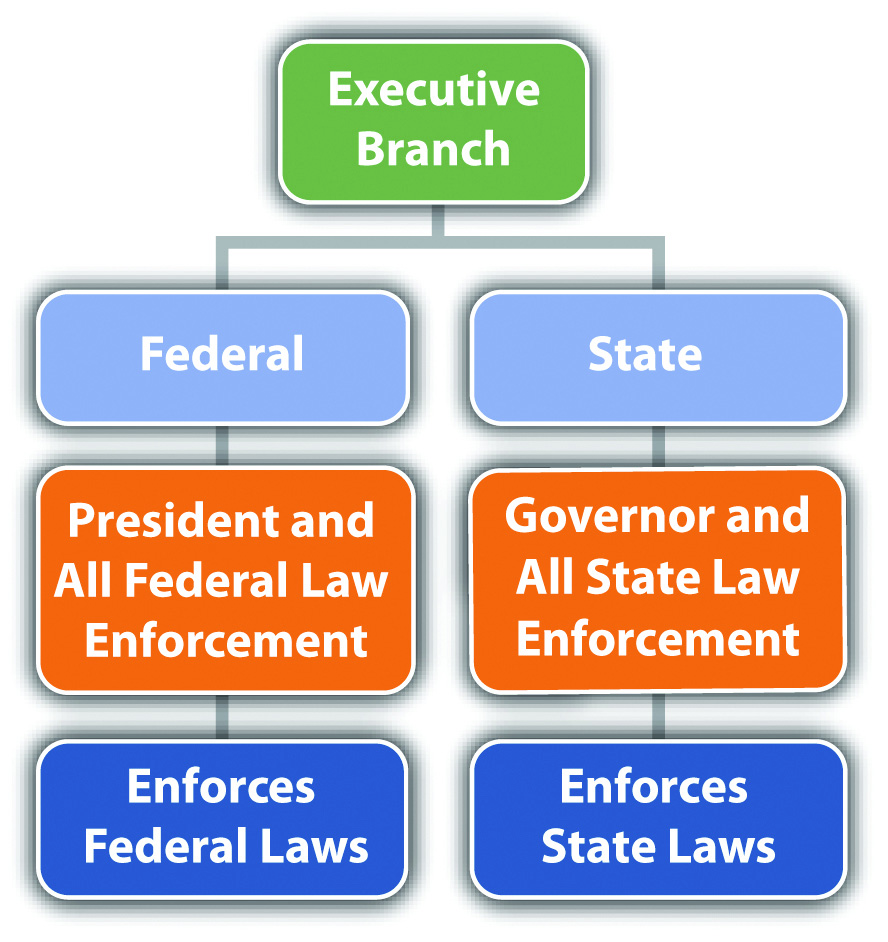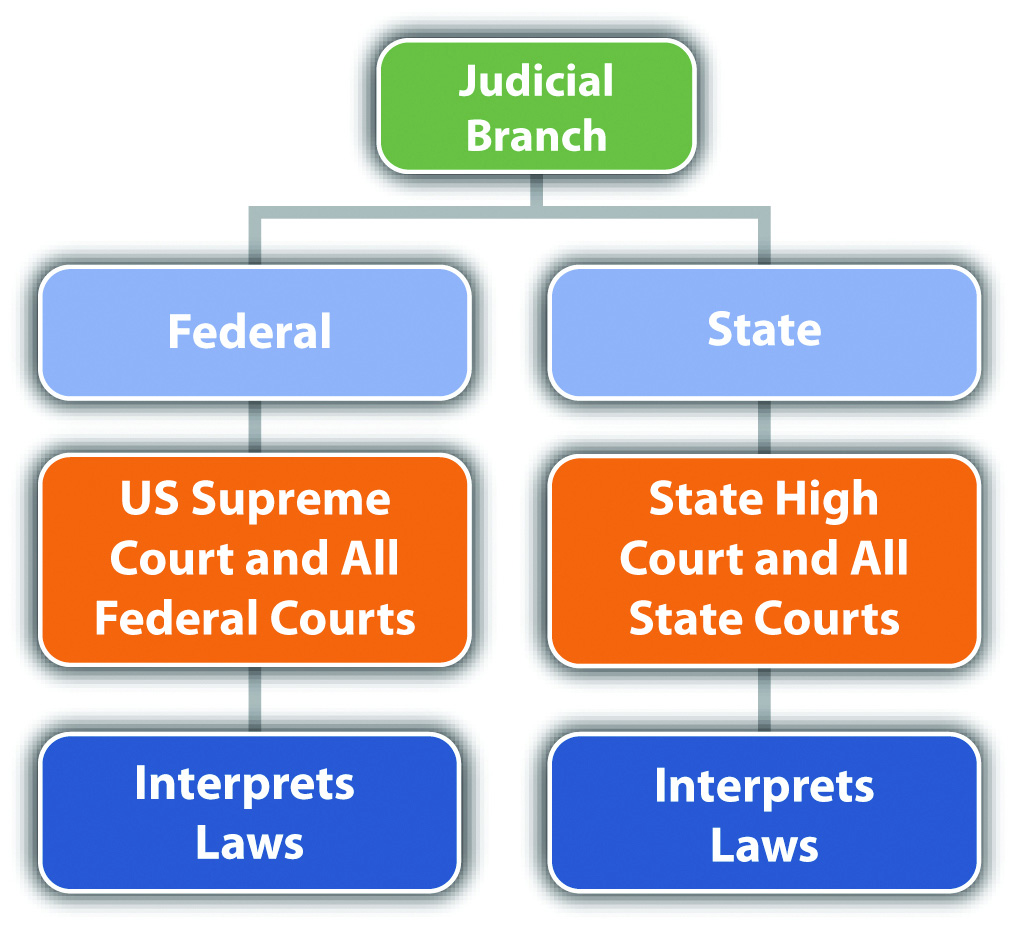2.2 The Branches of Government
Learning Objectives
- Identify the three branches of government.
- Ascertain the head of the federal and state legislative branches of government.
- Compare the Senate and the House of Representatives.
- Ascertain the head of the federal and state executive branches of government.
- Ascertain the head of the federal and state judicial branches of government.
The federal Constitution was written to ensure that government power is distributed and never concentrated in one or more areas. This philosophy is served by federalism, where the federal government shares power with the states. It is also further served by dividing the government into three branches, all responsible for different government duties and all checking and balancing each other. The three branches of government are detailed in Articles I–III of the federal Constitution and are the legislative branch, the executive branch, and the judicial branch. While the federal Constitution identifies only the federal branches of government, the principle of checks and balances applies to the states as well. Most states identify the three state branches of government in their state constitution.
Each branch of government has a distinct authority. When one branch encroaches on the duties of another, this is called a violation of separation of powers. The courts decide whether a government branch has overstepped its boundaries because courts interpret the Constitution, which describes each branch’s sphere of influence. Thus the judicial branch, which consists of all the courts, retains the balance of power.
The Legislative Branch
The legislative branch is responsible for creating statutory laws. Citizens of a state can vote for some state statutes by ballot, but the federal legislative branch enacts all federal statutes. In the federal government, the legislative branch is headed by Congress. States’ legislative branches are headed by a state legislature. Congress is bicameral, which means it is made up of two houses. This system provides equal representation among the several states and by citizens of the United States. States are represented by the Senate. Every state, no matter how large or small, gets two senators. Citizens are represented by the House of Representatives. Membership in the House of Representatives is based on population. A heavily populated state, like California, has more representatives than a sparsely populated state, like Alaska. States’ legislatures are generally bicameral and have a similar structure to the federal system.
Examples of Legislative Branch Checks and Balances
The legislative branch can check and balance both the executive branch and the judicial branch. Congress can impeach the president of the United States, which is the first step toward removal from office. Congress can also enact statutes that supersede judicial opinions, as discussed in Chapter 1 “Introduction to Criminal Law”. Similarly, state legislature can also impeach a governor or enact a state statute that supersedes a state case law.
The Executive Branch
The executive branch is responsible for enforcing the statutes enacted by the legislative branch. In the federal government, the executive branch is headed by the president of the United States. States’ executive branches are headed by the governor of the state.
Examples of Executive Branch Checks and Balances
The executive branch can check and balance both the legislative branch and the judicial branch. The president of the United States can veto statutes proposed by Congress. The president also has the authority to nominate federal justices and judges, who thereafter serve for life. State executive branches have similar check and balancing authority; a governor can generally veto statutes proposed by state legislature and can appoint some state justices and judges.
The Judicial Branch
The judicial branch is responsible for interpreting all laws, including statutes, codes, ordinances, and the federal and state constitutions. This power is all encompassing and is the basis for judicial review, referenced in Chapter 1 “Introduction to Criminal Law”. It allows the judicial branch to invalidate any unconstitutional law in the statutory source of law and also to change the federal and state constitutions by interpretation. For example, when a court creates an exception to an amendment to the constitution, it has made an informal change without the necessity of a national or state consensus. The federal judicial branch is headed by the US Supreme Court. Each state’s judicial branch is headed by the highest-level state appellate court. Members of the judicial branch include all judges and justices of every federal and state court in the court system, which is discussed shortly.
Examples of Judicial Branch Checks and Balances
The judicial branch can check and balance both the legislative branch and the executive branch. The US Supreme Court can invalidate statutes enacted by Congress if they conflict with the Constitution. The US Supreme Court can also prevent the president from taking action if that action violates separation of powers. The state courts can likewise nullify unconstitutional statutes passed by the state legislature and void other executive branch actions that are unconstitutional.
Table 2.1 The Most Prominent Checks and Balances between the Branches
| Government Branch | Duty or Authority | Check and Balance | Government Branch Checking and Balancing |
|---|---|---|---|
| Legislative | Create statutes | President can veto | Executive |
| Executive | Enforce statutes | Congress can override presidential veto by 2/3 majority | Legislative |
| Judicial | Interpret statutes and Constitution | President nominates federal judges and justices | Executive |
| Executive | Enforce statutes | Senate can confirm or reject presidential nomination of federal judges and justices | Legislative |
| Executive | Enforce statutes | Congress can impeach the president | Legislative |
| Legislative | Create statutes | Courts can invalidate unconstitutional statutes | Judicial |
| Executive | Enforce statutes | Courts can invalidate unconstitutional executive action | Judicial |
| Judicial | Interpret statutes and Constitution | Statutes can supersede case law | Legislative |
Key Takeaways
- The three branches of government are the legislative branch, the executive branch, and the judicial branch.
- The head of the federal legislative branch of government is Congress. The head of the state legislative branch of government is the state legislature.
- The Senate represents every state equally because each state has two senators. The House of Representatives represents each citizen equally because states are assigned representatives based on their population.
- The head of the federal executive branch of government is the president. The head of each state executive branch of government is the governor.
- The head of the federal judicial branch of government is the US Supreme Court. The head of each state judicial branch of government is the highest-level state appellate court.
Exercises
Answer the following questions. Check your answers using the answer key at the end of the chapter.
- A mayor enacts a policy that prohibits police officers in his city from enforcing a state law prohibiting the possession and use of marijuana. The mayor’s policy specifically states that within the city limits, marijuana is legal to possess and use. Which constitutional principle is the mayor violating? Which branch of government should check and balance the mayor’s behavior in this matter?
- Read Youngstown Sheet & Tube Co. v. Sawyer, 343 U.S. 579 (1952). In Youngstown, President Truman seized control of steel mills to avert a strike, using his authority as commander in chief of the armed forces. President Truman wanted to ensure steel production during the Korean War. Did the US Supreme Court uphold President Truman’s action? Why or why not? The case is available at this link: http://supreme.justia.com/us/343/579/.
- Read Hamdi v. Rumsfeld, 542 U.S. 507 (2004). In Hamdi, the US Supreme Court reviewed the US Court of Appeals for the Fourth Circuit’s decision prohibiting the release of a US citizen who was held as an enemy combatant in Virginia during the Afghanistan War. The citizen’s detention was based on a federal statute that deprived him of the opportunity to consult with an attorney or have a trial. Did the US Supreme Court defer to the federal statute? Why or why not? The case is available at this link: http://scholar.google.com/scholar_case?case=6173897153146757813&hl=en&as_sdt=2&as_vis=1&oi=scholarr.




